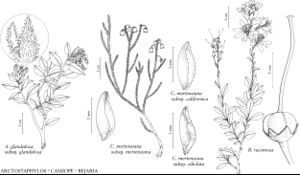Bejaria
Mant. Pl., 152, 242. 1771, orthography conserved (as Befaria) ,.
Shrubs [trees]. Stems erect; twigs glabrous. Leaves persistent, alternate, (reduced in size proximal to inflorescence); petiole present; blade chartaceous [coriaceous], margins entire. Inflorescences terminal racemes or panicles, 2–5-flowered, sometimes flowers solitary; perulae absent. Flowers bisexual, radially symmetric; sepals [5] 7, connate for 1/2 their lengths; petals [5–]7, distinct, (covered with sticky exudate), corolla deciduous, rotate; stamens [10] 14, included; anthers without awns, dehiscent by terminal pores; ovary [5–]7-locular; style barely exserted; stigma 7-lobed [capitate]. Fruits capsular, depressed-oblong, dehiscence septicidal. Seeds ca. 100–300, ellipsoid [oblong], without wings, with very short tail; testa long-celled reticulate.
Distribution
se United States, Mexico, West Indies (Cuba), Central America, South America.
Discussion
Species 15 (1 in the flora).
Bejaria is widespread in Latin America, where it is an important component of the subparamo flora. Bejaria racemosa is placed in the monotypic section Racemosae Fendchenko & Basilevskaja because of its chartaceous leaves without prominent abaxial midveins and the inflorescence that appears stalked because of the marked reduction in leaf size below the inflorescence. The original spelling, Befaria, has been shown to be an orthographic error.
